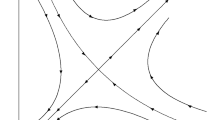Abstract
In this paper, we study an economic model, where internal habits play a role. Their formation is described by a more general functional form than is usually assumed in the literature, because a finite memory effect is allowed. Indeed, the problem becomes the optimal control of a standard ordinary differential equation, with the past of the control entering both the objective function and an inequality constraint. Therefore, the problem is intrinsically infinite dimensional. To solve this model, we apply the dynamic programming approach and we find an explicit solution for the associated Hamilton–Jacobi–Bellman equation, which lets us write the optimal strategies in feedback form. Therefore, we contribute to the existing literature in two ways. Firstly, we fully develop the dynamic programming approach to a type of problem not studied in previous contributions. Secondly, we use this result to unveil the global dynamics of an economy characterized by generic internal habits.
Similar content being viewed by others
Notes
Other contributions to the literature have studied external habits, i.e., habits formed over the whole economy average of past consumption (e.g., Augeraud-Veron and Bambi [1]). In this article, we study only the case of internal habits and we will often refer to them simply as habits.
The equity premium puzzle refers to the inability of models without habit formation, to explain the differential between the risky rate of return of the stock market and the riskless rate of interest, within reasonable parameter choices.
The case \(\gamma =1\) can be treated exactly as the other ones. Section 3.6 explains the main features of this case.
The space \(L^1_{loc}([0,+\infty [;{\mathbb {R}}_+)\) is the set of all functions from \([0,+\infty [\) to \({\mathbb {R}}_+\) that are Lebesgue measurable and integrable on all bounded intervals.
In the following we will indicate with \(W^{1,2}\) the Sobolev space defined as
$$\begin{aligned} W^{1,2}:=\{f\in L^{2}\left( \left[ -\tau ,0\right] ;{\mathbb R}\right) ,Df\in L^{2}\left( \left[ -\tau ,0\right] ;\mathbb {R}\right) \}. \end{aligned}$$
References
Augeraud-Veron, E., Bambi, M.: Endogenous growth with addictive habits. J. Math. Econ. 56, 15–25 (2015)
Constantinides, G.: Habit formation: a resolution of the equity premium puzzle. J. Polit. Econ. 98(3), 519–543 (1990)
Becker, G.S., Murphy, K.M.: A theory of rational addiction. J. Polit. Econ. 96(4), 675–700 (1988)
Crawford, I.: Habits revealed. Rev. Econ. Stud. 77(4), 1382–1402 (2010)
Fabbri, G., Gozzi, F.: Solving optimal growth models with vintage capital: the dynamic programming approach. J. Econ. Theory 143, 331–373 (2008)
Agram N., Haadem, S., Oksendal, B., Proske, F.: A maximum principle for infinite horizon delay equations. arXiv:1206.6670v1 (2012)
Li, J.K., Yong, S.M.: Optimal Control of Infinite Dimensional Systems. Birkhauser, Basel (1998)
Boucekkine, R., Fabbri, G., Gozzi, F.: Maintenance and investment: complements or substitutes? A reappraisal. J. Econ. Dyn. Control 34, 2420–2439 (2010)
Bambi, M., Fabbri, G., Gozzi, F.: Optimal policy and consumption smoothing effects in the time to build AK model. Econ. Theor. 50(3), 635–669 (2012)
Bambi, M., Gori, F.: Unifying time to build theory. Macroecon. Dyn. 18, 1713–1725 (2014)
Faggian, S., Gozzi, F.: Solving optimal growth models with vintage capital: the dynamic programming approach. Math. Popul. 143, 331–373 (2008)
Faggian, S., Gozzi, F.: Optimal investment models with vintage capital: dynamic programming approach. J. Math. Econ. 46(4), 416–437 (2010)
Faggian, S.: Infinite dimensional Hamilton–Jacobi equations and applications to boundary control problems with state constraints. SIAM J. Control Optim. 47(4), 2157–2178 (2008)
Boucekkine, R., Fabbri, G., Gozzi, F.: Egalitarism under population change: the role of growth and lifetime span. J. Math. Econ. 55(1), 86–100 (2014)
Ryder, H., Heal, G.: Optimal growth with intertemporally dependent preferences. Rev. Econ. Stud. 40, 1–31 (1973)
Hale, J.K., Verduyn Lunel, S.M.: Introduction to Functional Differential Equations. Springer, Berlin (1993)
Diekmann, O., Van Gils, S.A., Verduyn Lunel, S.M., Walther, H.O.: Delay Equations. Springer, Berlin (1995)
Bellman, R., Cooke, K.: Differential-Difference Equations. Academic Press, New York (1963)
Fleming, W.H., Soner, H.M.: Controlled Markov Processes and Viscosity Solutions. Springer, Berlin (2005)
Freni, G., Gozzi, F., Salvadori, N.: Existence of optimal strategies in linear multisector models. Econ. Theor. 29(1), 25–48 (2006)
Vinter, R.B., Kwong, R.H.: The infinite time quadratic control problem for linear systems with state and control delays: an evolution equation approach. SIAM J. Control Optim. 19(1), 139–153 (1981)
Bensoussan, A., Da Prato, G., Delfour, M.C., Mitter, S.K.: Representation and Control of Infinite Dimensional System. Birkhäuser, Boston (1992)
Bambi, M., Di Girolami, C., Federico, S., Gozzi, F.: On the consequences of generically distributed investments on flexible projects in an endogenous growth model. Econ. Theor. 63(2), 521–558 (2016)
Author information
Authors and Affiliations
Corresponding author
Additional information
Communicated by Vladimir Veliov.
Rights and permissions
About this article
Cite this article
Augeraud-Veron, E., Bambi, M. & Gozzi, F. Solving Internal Habit Formation Models Through Dynamic Programming in Infinite Dimension. J Optim Theory Appl 173, 584–611 (2017). https://doi.org/10.1007/s10957-017-1073-8
Received:
Accepted:
Published:
Issue Date:
DOI: https://doi.org/10.1007/s10957-017-1073-8




